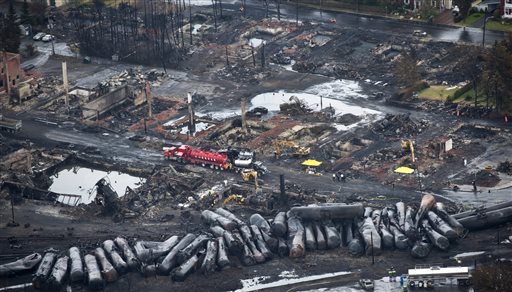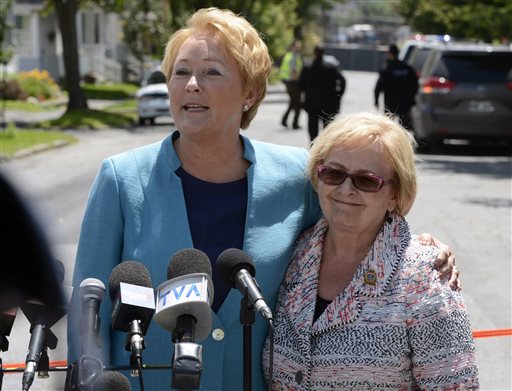LAC-MEGANTIC, Quebec — The first victim of a runaway oil train’s explosive derailment in a Quebec town was identified Thursday, more than five days since the disaster, which left behind a scorched scene so dangerous that it slowed the search for 50 people presumed dead.
Quebec’s premier toured the traumatized town and sharply criticized the U.S. railway’s chief for not responding in person more quickly to Canada’s worst railway disaster in nearly 150 years.
Police said four more bodies had been found, bringing the total found to 24.
The first victim to be identified by the coroner’s office was 93-year-old Eliane Parenteau, who lived in the disaster zone in downtown Lac-Megantic. Those who knew her described her as being active for her age.
The devastated downtown remained dangerous for days after the crash as responders put out fires and struggled to keep the remaining oil tankers cool so they wouldn’t explode. The hazardous conditions delayed the search for the missing – and now for bodies.
Officials also have warned that identifications would be made more difficult by the incinerated scene.
Conditions had at least improved enough for nearly all the 2,000 residents forced to evacuate after the crash – a third of the population – to return home, the town’s mayor said.
Quebec Premier Pauline Marois arrived in town and renewed her criticism of Edward Burkhardt, president and CEO of U.S.-based Rail World Inc., which owns the runaway train.
“The leader of this company should have been there from the beginning,” Marois said at a news conference.
Burkhardt arrived in town for the first time Wednesday with a police escort, facing jeers from residents.
Burkhardt has said he delayed his visit to deal with the crisis from his Chicago office, saying he was better able to communicate from there.
“I understand the extreme anger,” he said. “We owe an abject apology to the people in this town.”
He has blamed the engineer for failing to set the brakes properly before the unmanned train hurtled down a seven-mile incline, derailed and ignited. All but one of its 73 cars was carrying oil, and at least five exploded.
Burkhardt said the engineer had been suspended without pay and was under “police control.” Burkhardt did not name the engineer, though the company had previously identified the employee as Tom Harding of Quebec. Harding has not spoken publicly since the crash.
Anger at the railway officials among residents appeared to mount Thursday.
Lac-Megantic’s mayor, Colette Roy-Laroche, said a hoped-for meeting with Burkhardt didn’t materialize.
“I am angry with the fact that he did not communicate with me sooner,” she said.
At Burkhardt’s head office, an aide said no snub of the mayor was intended.
“There’s been a misunderstanding on that issue,” said Cathy Aldana. “Our people have been in contact with mayor’s office daily, and I know Mr. Burkhardt wanted to see her personally.”
Investigators are also looking at a fire on the same train just hours before the disaster. A fire official has said the train’s power was shut down as standard operating procedure, meaning the train’s air brakes would have been disabled. In that case, hand brakes on individual train cars would have been needed.
The derailment is Canada’s worst railway disaster since a train plunged into a Quebec river in 1864, killing 99.
The crash has raised questions about the rapidly growing use of rail to transport oil in North America, especially in the booming North Dakota oil fields and Alberta oil sands far from the sea.
Send questions/comments to the editors.



